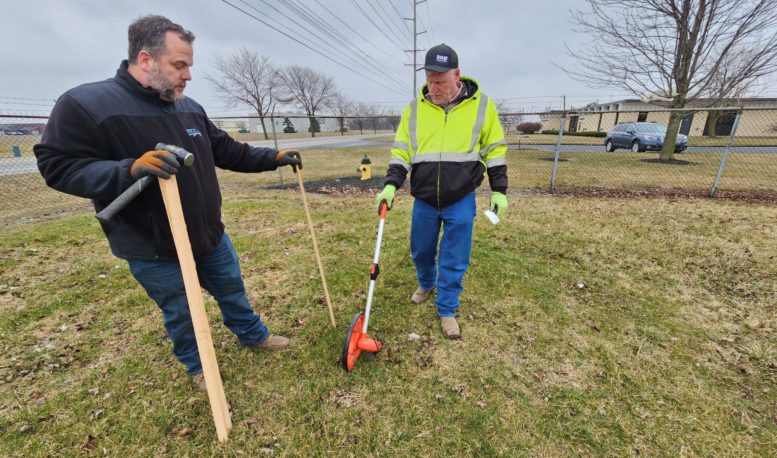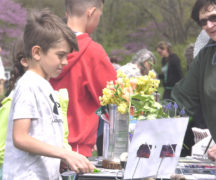By JAN LARSON McLAUGHLIN
BG Independent News
For years, Cinda Stutzman daydreamed of returning acres of turf grass in Bowling Green to prairie grasses and native flowers.
On Wednesday, Stutzman and other city employees scoped out the latest city acreage to be converted to native prairie – on the grounds of the Bowling Green Wastewater Treatment Plant at the corner of East Poe and Dunbridge roads.
“Twenty years ago, I used to drive by here and think – that’s a perfect place to plant prairie grasses,” said Stutzman, the city’s natural resources specialist.
Using a surveyor’s measuring wheel and pounding in stakes, city public works and wastewater treatment workers plotted out the acreage to see exactly how much land could be converted.

Bowling Green Sustainability Coordinator Amanda Gamby, who shares Stutzman’s dream, explained the planting of prairie grasses will serve two primary purposes.
First, the city’s public works department will save resources previously used for mowing. The 40-acre property at the wastewater treatment plant consumed long hours – and a lot of gas – to keep trimmed.
Second, the reduction in emissions and the planting of native prairie grasses and flowers will benefit the environment, Gamby said.
“It’s a more sustainable approach,” she said.
Planted will be historically native grasses and common prairie flowers to the Bowling Green region. So a third benefit will be the beauty of coneflowers, native goldenrods, asters and Indian grasses – plants that support monarch butterflies and pollinator plants used by bees such as a milkweed mix.
“I used to hoe that stuff out of cornfields,” public works employee Rick Beaverson said, noting the change in prairie plant philosophies, as he measured out acreage at the wastewater plant grounds on Wednesday.
In years to come, the city can plant different flowers and grasses, Gamby said.
“We can add more biodiversity over time,” she said.

The native planting on wastewater treatment acreage is the most recent effort to go natural on city-owned properties. Bowling Green has uprooted and replaced turf grass at the community center, the water treatment plant, the front acreage at Wintergarden Park, and portions of Simpson Garden Park. The acreage around the city’s solar field has also gone native.
To get rid of the grass prior to planting at the wastewater plant acreage, the public works staff will use chemicals.
“Unfortunately, that’s what it will take,” Stutzman said. In smaller acreage areas, the city has used tilling to get rid of turf. “But that requires a lot more repetition,” she said.
The efforts to return to native prairies represent a collaboration between city parks, sustainability and public works departments, according to Gamby.
“It’s been really cool,” she said.
The City of Bowling Green has been strategically converting its green spaces from high-maintenance grass to low-maintenance native vegetation. Over the years, the city’s focus has primarily been on increasing native spaces within its park properties and surrounding the solar field property. This year, those efforts are expanding to the city’s wastewater and water treatment facilities.
Throughout this year’s growing season, the areas to be planted will look dead. But they will quickly bounce back to life next spring after the seeds, which will be planted this fall with assistance from Pheasants Forever, begin to grow with the warmer months and spring rains.
This restoration process will take approximately three years to complete. Native flowers and prairie grasses will grow to an average height of 3-4 feet and cover most of the area surrounding the wastewater treatment facility (14.5 acres) and a large portion of the front lawn of the water treatment facility (1.5 acres).





